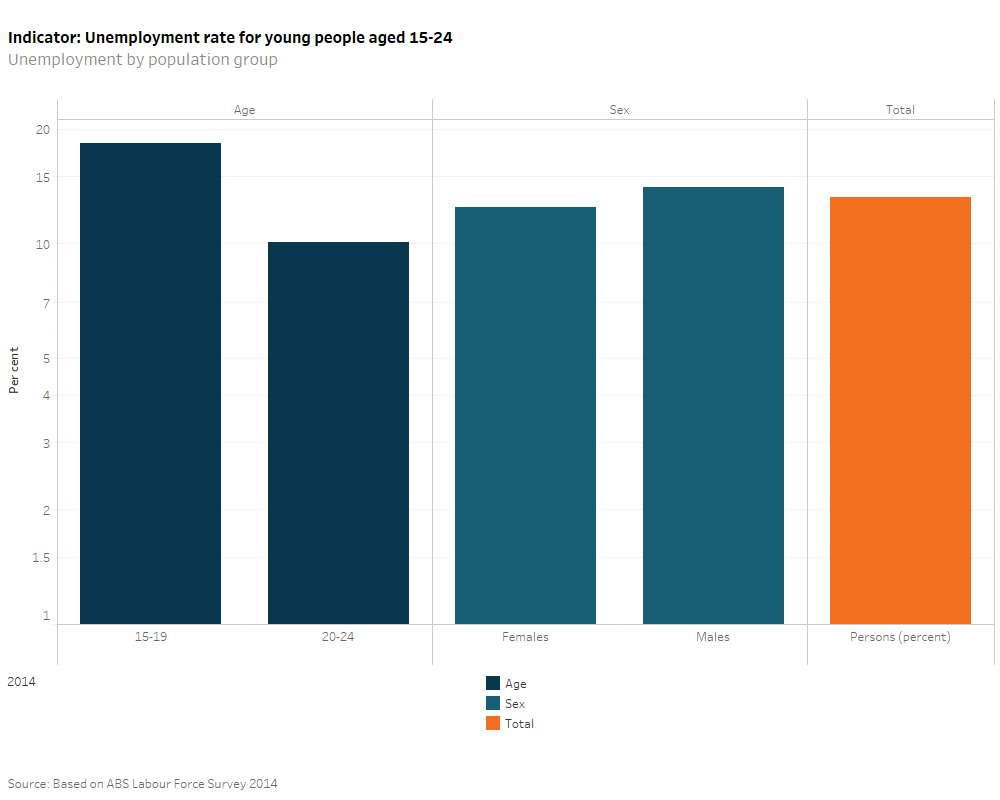Unemployment & underemployment
Why are unemployment and underemployment rates important?
The completion of full-time education and the transition to full-time employment are major milestones for young people. Youth employment (and thus unemployment) trends have implications for the ability of young people to successfully make the transition from study to work and subsequently to independent living, particularly given the increases in youth unemployment and underemployment following the global financial crisis (Bell and Blanchflower 2011; CEPR 2015; OECD 2009).
Youth unemployment or educational inactivity have negative long-term consequences on career prospects for young people. Unemployment and its associated impact on young people’s economic resources can damage self-esteem; it also increases the likelihood of depression and has been linked to significant effects on weekly wages and happiness at age 50 (Bell and Blanchflower 2011; OECD 2010).
A large number of young people who are employed are considered to be ‘underemployed’- meaning that they would prefer, and are available for, more hours of work than they currently have (see Notes section for full definition).
Do rates vary across population groups?
Young people experience unemployment at a higher rate than the overall population. In 2014 the youth unemployment rate for 15–24 year olds (13%) was more than twice the national employment rate of 6% (AIHW 2015).
In 2014, 15–19-year-old young people reported a higher rate of unemployment than young people aged 20–24 (about 18% versus 10% respectively). Young males (15–24 years) were slightly more likely to be unemployed than females in 2014 (about 14% versus 13% respectively).
In the same year, the underemployment rate among 15–24 year olds was 16%. Young females are more likely to be underemployed than young males (19% versus 14% respectively) (AIHW analysis of ABS 2015). The underemployment rate for young people was almost twice the rate for all ages (8.1%) (AIHW 2015).
Has there been a change over time?
Youth unemployment (15–24 years) has been increasing in recent years from 8.8% in 2008 to 13% in 2014. Since 2004, 15–19 years olds have consistently reported higher unemployment rates than 20–24 year olds. Young males (aged 15–24) are also slightly more likely to be unemployed than young females. In 2004, for 15–24 year olds, male unemployment was 12% increasing to 14% in 2014, with female unemployment at 11% in 2004, increasing to 13% in 2014.
The underemployment rate has been variable since 2004, however, underemployment appears to be increasing in recent years from 11% in 2008 to 16% in 2014.

This report is based on survey data; relative standard errors and 95% confidence intervals were not provided with the source data. Consequently, significance testing has not been undertaken.
Unemployed young people are defined as those aged 15 and over who were not employed during the reference week and; had actively looked for full time or part time work at any time in the four weeks up to the end of the reference week and were available for work in the reference week; or were waiting to start a new job within four weeks from the end of the reference week and could have started in the reference week if the job had been available then.
Underemployed workers are employed people who would prefer, and are available for, more hours of work than they currently have. They comprise; part-time workers who would prefer to work more hours and were available to start work with more hours, either in the reference week or in the four weeks subsequent to the survey, and; full-time workers who worked part-time hours in the reference week for economic reasons (such as being stood down or insufficient work being available). It is assumed that these people would prefer to work full time in the reference week and would have been available to do so.
ABS 2015 Labour Force, Australia, Detailed – Electronic Delivery, Feb 2015
Data quality statement: ABS Labour Force Survey
AIHW (Australian Institute of Health and Welfare) 2015. Australia’s Welfare 2015. Canberra: AIHW.
Bell DNF & Blanchflower DG 2011. Youth Unemployment in Europe and the United States. IZA Discussion Paper No. 5673. Viewed 21 May 2015.
CEPR (Centre for Economic Policy Research) 2015 No Country for Young People? Youth Labour Market Problems in Europe, Edited by JJ Dolado. A VoxEU.org Book. Viewed 21 May 2015.
OECD (Organisation for Economic Co-operation and Development) 2009. Jobs for Youth: Australia 2009. OECD Publishing. Viewed 21 May 2015.
OECD 2010. Off to a Good Start? Jobs for Youth. OECD Publishing. Viewed 21 May 2015.


